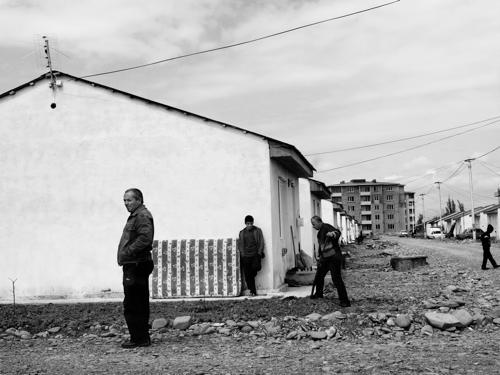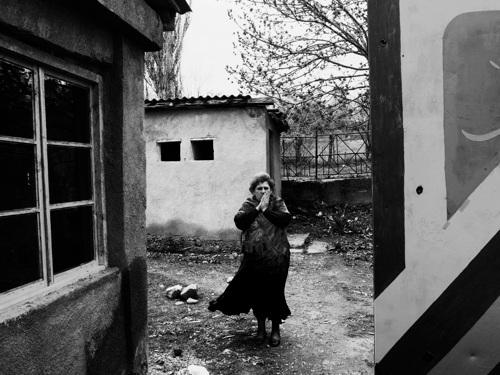
More than fifteen months have passed since war broke out between Georgia and Russia. The war lasted five days, the amount of time it took for the Russian army to rout Georgia’s tiny, American-trained defense forces. It was the most serious military conflict in Europe since the Balkans. And yet, although tens of thousands of people are still displaced, and Russia is posing an increasing threat to Georgia’s oil pipelines, both the EU and the US may be powerless to prevent further threats to the country.
At home, the war has played well for Russian President Dimitry Medvedev. It marks Russia’s first unequivocal military victory since World War II. Russian troops have seized control of the disputed provinces of South Ossetia and Abkhazia, assigning them the status of breakaway independent republics. (For the Abkhazians, long suspicious of the Georgian government, this has not been entirely unwelcome.) Russia has asserted its control over what Medvedev has called its “zone of privileged interest.” The most pro-West state on its border has been humbled, sending a message to the Ukraine and other West-leaning former Soviet Republics that Russian hard power is once again to be feared. More important, the war has demonstrated that neither the European Union nor the United States will risk seriously damaging relations with Russia in order to protect a state in Russia’s backyard, no matter how liberal and democratic that state claims to be.
Georgia, for its part, which was at the time of the war half the size of North Carolina with a population of 4.7 million, has seen its territory shrink by twenty percent. President Mikheil Saakashvili’s hope of joining NATO has receded into the remote distance, a development that, in any event, Russia would never have abided.
An international aid official in Tbilisi, with whom I talk frequently, reports a general feeling of pessimism in the capital. A completely deregulated, free-market ethos continues to hold sway, but with the ending both of the war and the global economic expansion, Tbilisi is dotted with half-finished high-rises, empty nightclubs, and stalled development projects. Yet paradoxically, Saakashvili faces less popular opposition than before the war. His most prominent challenger is the moderate former UN Ambassador Irakli Alasania, who is almost certain to run for president when Saakashvili’s term ends in 2013. On November 7, the opposition staged a demonstration to mark the anniversary of a government crackdown in 2007, when opposition leaders were arrested and media outlets shut down. Tbilisians were warned it might become violent, but the turnout was modest, barely disrupting traffic.
The European’s Union’s report on the cause of the war was finally made public in September after a series of delays to accommodate a bombardment of putative “proof” about what really happened from both sides. The report takes Georgia to task for throwing the first punch, and reproves Moscow for using “disproportionate force” in responding to the provocation. It is hard to imagine what Saakashvili was expecting to gain when he ordered the shelling of Tskhinvali, the South Ossetian capital, on August 7, 2008.
The most plausible explanation is that he misunderstood the limits of the Bush administration’s support for his anti-Russian stance. After 9/11 Bush promoted Georgia to the status of a crucial American ally, a steadfast member of “the coalition of the willing” in the US’s “war on terror,” and promised to press for Georgia’s membership in NATO. Emblems of the importance to Georgia of its alliance with the US are everywhere. The major road from the international airport to Tbilisi, for instance, is called “George W. Bush Street.”

Bush’s rhetoric, combined with generous amounts of US military and economic aid, seems to have imbued Saakashvili with an unrealistic sense of Georgia’s strategic importance. In expecting Washington to intervene militarily in support of a border war that he himself provoked, Saakashvili appears to have overlooked the fact that the US needs Russia’s cooperation to help carry out its larger strategies in Afghanistan and Iran.
France and Germany, for their part, are too dependent on Russian energy to risk straining relations with Moscow. The giant Russian company Gazprom supplies Europe with 28 percent of its natural gas. In a joint venture with Germany, Gazprom is in the process of building the $10.7 billion Nord Stream pipeline, which would run 750 miles under the Baltic Sea, directly from Russian to Germany, bypassing existing routes through Ukraine and other parts of East Europe for the first time. With the new pipeline Russia will be able to shut off energy supplies to the Ukraine for instance, without interrupting flow to its customers in the West.
Former German chancellor Gerhard Schroder brokered the deal for the pipeline, later becoming chairman of Nord Stream. The German government guaranteed $1.46 billion for the project shortly before Schroder lost his bid for reelection in 2005. Wary of losing out to the Germans, Gaz de France is now seeking to join the consortium. Under the circumstances, one can expect Western Europe to become even more muted in its criticism of Russia’s actions in its so-called privileged zone.
Advertisement
Georgia, in the meantime, becomes increasingly irrelevant. It is in the unenviable position of having no valuable natural resource to leverage other than the oil and gas pipelines that pass through its territory from the Caspian basin, supplying Western Europe with its only alternative to Russian energy. In the future, Nord Stream will weaken the importance of those pipelines. To make matters worse, having gained control of South Ossetia and Abhkazia, the Russian army is within easy striking distance of the Caspian pipelines should it decide to disable them.
Saakashvili himself often seems to behave more like a CEO than a head of state—drumming up foreign investment in an attempt to make up for the country’s steep losses. Since the end of the war Georgia has received $4.5 billion in international aid, an enormous amount for a country of its size. Recently, Saakashvili has sent troops to Afghanistan, and the US (Vice President Biden, for one, is an enthusiastic supporter) is actively helping Georgia rebuild its defense forces.
The unequivocal losers are the ethnic Georgians that formerly lived in the breakaway provinces. About 850 people died in the war, including 132 South Ossetians, quite a different number from the 1,500–2,000 victims the Russians originally claimed. But 138,000 people fled the occupied provinces, many of them into Georgia, and about 30,000 ethnic Georgians have failed to return.
South Ossetia, with forty percent of its capital destroyed, seems condemned to a future of poverty and civil unrest; and Abkhazia faces the certainty of a second invasion in the form of rich Russians buying up its coastland to build resorts and second homes. The legal status of the provinces remains ambiguous, providing a ready-made pretext for another war, one that neither the United States nor Western Europe would seem to have the will or political interest to prevent.
Alex Majoli’s photographs appear in the new book Georgian Spring, a travel journal by ten Magnum photographers who visited Georgia during the spring of 2009 at the invitation of Georgia’s Ministry of Culture. The book features work by Antoine D’Agata, Jonas Bendiksen, Thomas Dworzak, Martine Franck, Majoli, Gueorgui Pinkhassov, Martin Parr, Paolo Pellegrin, Mark Power, and Alec Soth. It also includes archive photographs by Robert Capa and Henri Cartier-Bresson, an essay by Wendell Steavenson, and a foreword by Dworzak. It will be published by Magnum Photos and Chris Boot in December. Further photographs and multimedia projects related to the book are available here.

